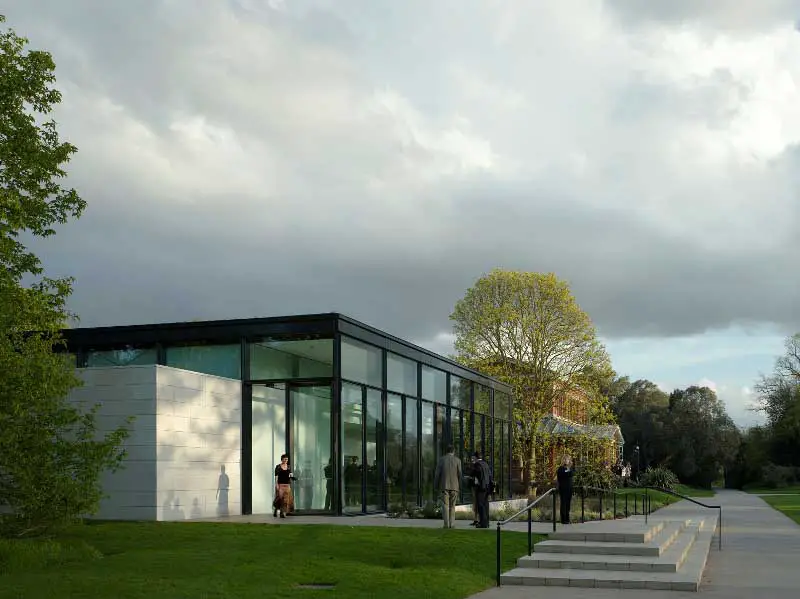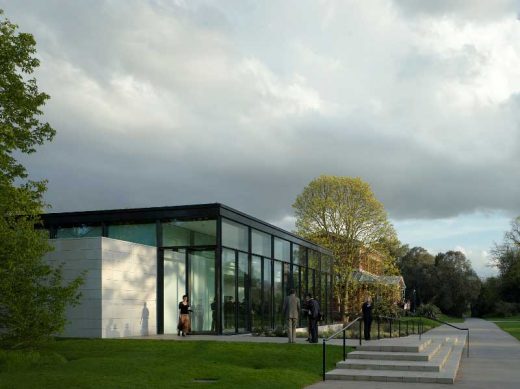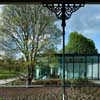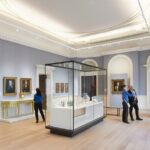Shirley Sherwood Gallery Kew, Architect, London Architecture Photos, Botanical Art, News
Shirley Sherwood Gallery Architecture
Royal Botanic Gardens development, London, England, UK
15 Mar 2010
Shirley Sherwood Gallery Kew
Civic Trust Awards 2010 – Award winner
World’s first public gallery of botanical art to open at Kew gardens
London, 8 Apr 2008
The Shirley Sherwood Gallery at Kew Gardens, opening on Saturday 19 April, will be the first public gallery in the world dedicated to botanical art and will be open to the public all year round. The state-of-the-art gallery, designed by award-winning architects Walters and Cohen, will exhibit precious works of art from the collections of the Royal Botanic Gardens, Kew, and Dr Shirley Sherwood, many of which have never been on public display before.
Kew Gallery of Botanical Art by Walters & Cohen:
In 2004 London-based architecture firm Walters and Cohen was commissioned by Royal Botanic Gardens, Kew, through a framework agreement, to design The Shirley Sherwood Gallery. Walters and Cohen worked closely with Kew to design an elegant, innovative building that is energy efficient, appropriate to this historically important and sensitive site, and future-proofed to adapt as needs change.
It was crucial that the design sought to combine the needs of the collection and those of Kew’s visitors. In response, Walters and Cohen maximised the gallery’s internal space by creating a ‘box within a box’ configuration, which capitalizes on views across the beautiful surroundings of Kew Gardens, whilst maintaining a controlled internal environment (50 lux and 55% relative humidity) to protect the fragile artworks.
The main central gallery space is flanked by four small galleries with the same climate and light controls, each of which can be closed off without disrupting visitor flow. Displays in these spaces can be integrated with the main exhibition or used as discrete spaces for the display of ‘treasures’ from Kew’s collections or for regularly changing topical displays relating to current affairs or developments in plant science and conservation. The exhibition spaces, totalling 300m2, have been designed to be as flexible as possible, by using versatile display and lighting systems.
High level glazing in the central gallery features retractable black-out blinds that run on an environmentallycontrolled system, providing visitors with a panorama of the night sky during private views and events, and for less environmentally sensitive exhibitions. Two of the external walls of the gallery space are glazed to create a welcoming and accessible reception and orientation area where prints, an Art on Demand service and some publications can be displayed.
Materials have also been sensitively selected to complement and contrast with the Victorian structure of the adjacent Marianne North Gallery, which contains a unique display of botanical and landscape paintings by the renowned Victorian artist and explorer.
The new gallery pavilion has been carefully sited in the landscape of Kew Gardens between two significant TROBI (Tree Register of the British Isles) trees. The scale and proportion of the new gallery is driven by the architectural language of the adjacent building, and this precisely detailed gem will make a valuable contribution to the important architectural heritage at Kew Gardens.
Cindy Walters from Walters and Cohen commented, “It is a wonderful privilege to design a building that will host one of the world’s greatest collections of botanical art. The 200,000 strong collection is hugely important globally, both scientifically and artistically, and some of the artworks portray species which are now extinct and may be the only surviving record.
“Many of the artworks are extremely light-sensitive and require a climate-controlled environment, so we have paid particular attention to designing a building that will protect these unique works, as well as providing a welcoming and flexible space that visitors will enjoy for many years to come.”
Professor Stephen Hopper, Director of the Royal Botanic Gardens, Kew, said, “The gallery will make Kew’s and Shirley Sherwood’s collection of contemporary botanical art accessible to everyone who visits Kew. These great works of art will be of interest to the general public, but they are also scientific tools highly valued by taxonomists, horticulturalists, historians and researchers alike.
“These artworks will provide opportunities to tell stories of individual plants from around the world. With a significant proportion of the world’s species of flowering plants threatened by extinction in the next 50 years, Kew has a vital role to play to inspire and deliver science-based plant conservation. The beauty, rarity and accuracy of the images displayed in The Shirley Sherwood Gallery will raise public awareness of the beauty and fragility of the natural world.”
Until now, although the Royal Botanic Gardens, Kew collection has been consulted by experts and researchers, most of the works have been kept in study collections behind the scenes. Some works have rarely, if ever, been seen by the public and to this day they are still used for scientific purposes in preference to photography, because drawing is capable of demonstrating the entire lifecycle of a plant from various viewpoints. The new gallery provides the right environment and will make Kew’s collections more accessible, ensuring that the 1.3 million annual visitors to Kew Gardens can see the treasures on public display.
The inaugural exhibition – ‘Treasures of Botanical Art: Icons from the Shirley Sherwood and Kew Collections’ – will run from April 2008 to October 2008.
A changing annual programme of three exhibitions is planned and the inaugural exhibition will combine some of the highlights from the Royal Botanic Gardens, Kew and The Shirley Sherwood Collections. The 2008 exhibition will show the scope of the two collections and the richness of botanical art as a whole, providing an overview of the most significant artists from c1700 through to the present day with support from sponsor Jonathan Cooper – Park Walk Gallery.
A book written by Dr Shirley Sherwood and Martyn Rix and published by Kew Publishing will accompany the exhibition and provide an introduction to the collections.
Future exhibitions include one in the autumn of 2008 that will focus on contemporary and historic images of trees, followed by a special exhibition to celebrate Kew’s 250th anniversary in 2009 and an exhibition called ‘The Art of Plant Evolution’ based on a new publication by Dr Shirley Sherwood and Professor John Kress.
‘Adopt a Painting’ to help restore the Marianne North Gallery
The Marianne North Gallery is a unique building holding a fascinating collection of one woman’s botanical art at the Royal Botanic Gardens, Kew. A vital restoration project, due to start in July 2008, will repair various features of the building, improve the conditions for the display of North’s collection and conserve and restore the collection itself. The ‘Adopt a Painting’ scheme offers people the chance, for as little as £500, to have a hand in safeguarding each painting’s future and supporting a unique artistic collection. For advice on how to Adopt a Painting in the Marianne North Gallery email mng@kew.org or call Helen Lawrence on 020 8332 3249.
Shirley Sherwood Gallery opening hours
The Shirley Sherwood Gallery will be open all day, as per the opening hours of the Gardens. Please see http://www.kew.org/visitor/timeskewl. Entrance to the gallery will be at no additional cost to Garden admission.
Shirley Sherwood Gallery information issued on behalf of Walters & Cohen Architects by ONG Media 150408
Shirley Sherwood Gallery Kew Gardens design : Walters & Cohen Architects
Walters & Cohen
Founded in 1994 by Cindy Walters and Michál Cohen, Walters and Cohen has since grown into a dynamic and multicultural practice of talented individuals from around the world with an international portfolio of public, education, commercial, housing and cultural projects.
RBG Kew’s Botanical Art Collection
Arranged systematically by plant families, Kew’s collection of botanical art, which forms part of the National Reference Collection, plays a key role in plant science research, particularly for the identification of plants. Assembled over the last 200 years, Kew holds works by the great masters of the eighteenth century, such as G D Ehret, the Bauer brothers and Redouté, nineteenth century artists including Walter Hood Fitch and Marianne North and twentieth century and contemporary botanical artists such as Margaret Mee, Stella Ross-Craig and Christabel King.
The collection also includes many of the original botanically precise watercolours from Curtis’s Botanical Magazine dating back to 1789. Among the Library’s 300,000 books and pamphlets are many lavishly illustrated and rare books dating back to 1370. In addition the archives contain the illustrated notebooks of great botanists and plant hunters – including Sir William Hooker, the first Director of Kew – and objets d’art, portraits, photographs and daguerreotypes.
Dr Shirley Sherwood
Dr Shirley Sherwood is Editor-in-Chief of the Orient-Express Magazine and contributed generously to the costs of constructing the gallery. She is Vice Chairman and a judge on the Picture Committee of the Royal Horticultural Society, London; a former trustee on the Advisory Board of the Royal Botanic Gardens, Kew; an honorary trustee of the American Society for Botanical Artists; a Fellow of the Linnean Society and on the Board of the Smithsonian 4 Institution.
She has written several books including Contemporary Botanical Artists: The Shirley Sherwood Collection and A Passion for Plants: Contemporary Botanical Masterworks. Parts of her collection have toured the United States including the Hunt Institute, Pittsburgh and Denver Art Museum. In 2003 she showed a hundred works at the Smithsonian in Washington, which were visited by over half a million people.
Kew Publishing
The publishing house of the Royal Botanic Gardens, Kew produces over 20 new titles each year catering for diverse readerships, from scientists and academics to the general public of all ages. We aim to inspire and educate people about our work and to make available Kew’s unique heritage and resources, knowledge and cutting-edge expertise to as wide an audience as possible throughout the world.
Royal Botanic Gardens, Kew
Kew Gardens is a major international visitor attraction and its 132 hectares of landscaped gardens attract over one million visitors per year. Kew is a UNESCO-inscribed World Heritage Site and represents over 250 years of historical landscape. The site houses over 40 listed buildings and other structures including the Palm House, Temperate House, Orangery and Pagoda as well as two ancient monuments, Queen Charlotte’s Cottage and Kew Palace.
RBG, Kew is a world famous scientific organisation, internationally respected for its outstanding living collection of plants and world-class herbarium as well as its scientific expertise in plant diversity, conservation and sustainable development in the UK and around the world.
Buildings for the Kew Gardens Architecture page welcome
Location: Shirley Sherwood Gallery of Botanical Art, Kew Gardens, London, England, UK
London Buildings
Contemporary London Architecture
London Architecture Designs – chronological list
London Architecture Walking Tours by e-architect
Kew Gardens – Kew Tree Tops Walkway, southwest London
Kew Gardens Walkway
Kew Gardens Herbarium, Library, Art and Archives
Edward Cullinan Architects
Kew Gardens Herbarium
The Sackler Crossing
Royal Botanic Gardens Kew : The Sackler Crossing
Taj Crowne Plaza London St James, 51 Buckingham Gate
Design: Broadway Malyan
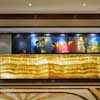
image from architects
Taj Crowne Plaza London St James
Coments / photos for the Shirley Sherwood Gallery London page welcome
Website: Kew Gardens London, UK

